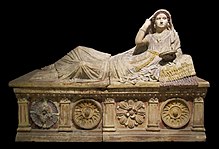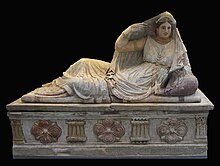Sarcophagus of Larthia Seianti
The sarcophagus of Larthia Seianti is an Etruscan artifact from the 2nd century BC. BC and was discovered near Chiusi in 1877 . Today the sarcophagus is in the National Archaeological Museum of Florence . It is one of the most important works of the late Etruscan sepulchral culture .
Description of the sarcophagus
The 1.64 m long, 54 cm wide and a total of 1.05 m high sarcophagus was made of terracotta and is covered with a white coating that is supposed to imitate marble . This layer was painted with intense bright colors. Although the colors have continued to fade since it was discovered, what remains of them can still be clearly seen. The sarcophagus is divided on the front by five triglyphs into four fields, which are alternately decorated with rosettes in the colors purple and red and two yellow paterae . The lid and sarcophagus each consist of two halves.
On the sarcophagus, Larthia Seianti is depicted half-lying as a middle-aged woman. She supports herself with her left arm on two striped pillows with long fringes. One pillow is yellow, the other purple, the stripes are each white. Her head is covered with a cloak, which she pulls to one side with her right hand. She has short, wavy hair that frames her forehead and temples. On her head she wears a diadem decorated with rosettes . The red dots in the rosettes are likely to represent gemstones.
She is holding a circular mirror in her left hand. The reflective surface is designed in blue, the frame in yellow. As with jewelry, the yellow color is supposed to imitate gold. She wears two gold bracelets on her right arm and six rings with carnelian red settings on her left hand. Amber stones with acorn pendants are likely to hang on their ears in gold. Around her neck she has a wide necklace and a longer chain with a Medusa head as a pendant.
Larthia Seianti wears a floor-length tunic and over it a thin stole that covers the head, shoulders, hips and legs. The tunic has a V-shaped neckline with a colored border. The tunic is bordered vertically by a wide purple ribbon between two narrow green stripes. The rest of the dress appears to be white. A braided golden belt with red decorations is tied around the tunic just below the breast, the ends of which hang down as an ornament. Her right foot protrudes from under the tunic, the other foot is covered because she keeps her left leg angled. The leather sandal on her right foot has a red cover with a green bar, which you can imagine to be made of bronze.
The sarcophagus is similar in style and technique to the sarcophagus of the Seianti Hanunia Tlesnasa , which comes from a single-chamber tomb near Chuisi and is now in the British Museum in London . The deceased is shown in the same posture and clothing as Larthia Seianti, but her body is more voluptuous and her face is fuller. Both people probably come from the same aristocratic family. The construction of the burial chambers and the style of the art objects found in them point to the 2nd century BC. Chr. Some recent research dates both sarcophagi to around 150 BC. According to another opinion, the sarcophagus of Larthia Seianti is 20 to 30 years older and dates from 170 to 180 BC. Chr.
The two Seianti sarcophagi are unusually finely crafted and richly decorated compared to other terracotta sarcophagi from this period. The colors used, such as the so-called Egyptian blue, of which remains can be found on the mirror, were precious and expensive. The painting of sarcophagi was not the rule, as numerous specimens from the area show. The production of the sarcophagus required great craftsmanship, as the figure and the sarcophagus were made from a total of four parts that were put together after firing. The figure was made by hand, probably using molds to decorate the sarcophagus.
A bride's jewelry
Among the Etruscans, a significant part of the artistic interest in women wearing jewelry focused on the representation of brides. Wedding ceremonies were an important opportunity to highlight the importance and wealth of the family through jewelry and clothing. Jewelry gifts for the bride were common in many ancient cultures. Some were certainly heirlooms, others were newly made by the bride's family with decorations according to family tradition. In this way, the bond with the bride's family remained intact while the bride joined her husband's family. Other pieces of jewelry may have been a gift from the groom or relatives as a sign that the new wife has joined the family. It can therefore be assumed that Larthia Seianti is portrayed as a bride, since her jewelry, including bracelets, necklaces, rings and a diadem, make up such an important part of her furnishings. The braided gold belt, tied with a Heracles knot or square knot, was also one of the attributes of a bride in antiquity.
Larthia Seianti's jewelry represents types that were common in the Mediterranean at the time and suggests a cosmopolitan aesthetic that was popular in the late Etruscan period. The Etruscans expanded their ornamentation to include Hellenistic forms, perhaps also because the Etruscans were exposed to stronger external influences in view of the growing Roman presence.
The representation as a portrait
The following stages can be distinguished in the development of the portrait : The first impulse for the portrait, which manifests itself in its most naive form, assigns a certain name to the general image. The typological portrait tries to indicate the status of the person depicted (a king, a warrior, a god, a priestess) and their age (young, old). The physiognomic portrait tries to imitate the individual characteristics of the person exactly and to reproduce the physical characteristics truthfully. Finally, the portrait is given a psychological expression that is supposed to reflect the character of the person portrayed.
In the figure of Larthia Seianti, the facial features and physiognomic features are hardly pronounced. The characterization of the face does not seem to go beyond the generic depiction of a young matrona flaunting her status and wealth. The similarity of the face with that of the Seianti Hanunia Tlesnasa also suggests that there is no particular match between the deceased and her image. The more recent research is therefore predominantly based on a simple typological portrait.
The inscriptions on the sarcophagus
Larthia Seianti's name was imprinted on the upper ledge before burning. The engraving was later plastered over and a name was painted on it, which today has almost completely disappeared and cannot be deciphered. In accordance with Etruscan writing habits, the letters are mirrored and arranged from right to left.
- Engraving: LARTHIA: SEIANTI: S ..... I: SVE ...
- Overpainting: ... TI .... A: LAR ... LISA: ....... NIASA
This leads to a certain uncertainty about the identity of the person buried here. The engraving probably names the name of the woman who was to be buried here first or who perhaps commissioned the sarcophagus without using it. The second name could refer to the woman who was actually buried in this sarcophagus after the first-named was not buried here for unknown reasons. Therefore, the real relationship between the deceased who was buried in this sarcophagus and the other people in the family grave is not clear.
The discovery of the grave
In 1877, 1 km northeast of Chiusi in the necropolis of Martinella, the multi-chambered grave of the Larcna family was discovered, in which the sarcophagus of Larthia Seianti was located. The owner of the tomb, and the only man buried there with four women, was Laris Larcna Cencual. He was buried in a simple, house-shaped sarcophagus. The ashes of his first wife, Fasi Velui, were kept in an urn . Larthia Seianti was probably his second wife. Seianzi Viliana, who was also buried in a sarcophagus, was initially considered the third woman, but was finally identified more convincingly as the patriarch's niece. The variety of burial types and the varying qualities of urns and sarcophagi found in a single grave are instructive. Larthia Seianti's sarcophagus was by far the most magnificent and, together with that of Seianti Hanunia Tlesnasa, a final artistic highlight in the production of sarcophagi for aristocratic families from Chiusi.
The grave goods are precious and testify to the high rank of the deceased. A collection of toiletries and miniature dishes made from silver, glass, alabaster, and bronze surrounded the sarcophagus:
- Silver: 1 pan; 1 crater ; 1 double comb; 3 paterae ; 3 pins; 1 teaspoon for cosmetics; 3 needles (one perhaps a fragment of a fibula ); 1 pair of tweezers.
- Glass: 5 game pieces with different colors.
- Alabaster: 2 amphorae .
- Bronze: 1 bottle.
The miniature tableware represents the aristocratic banquet, one of the typical manifestations of the life of the wealthy and a recurring theme in Etruscan tomb paintings. The special value of the metal with which these items were made is further evidence of the wealth of the deceased. Their splendid honor beyond death underlines the special role of women, at least in the Etruscan aristocracy. Etruscan women, unlike Greek women, were allowed to lie at the table on the kline and, unlike many Roman women of the late republic, had their own first name and often a female gentile name .
Inside the sarcophagus, a worn Roman coin was found, an uncia - ace with a Janus head on the obverse and a ship's bow on the reverse. Coins of this type were made between 189 and 180 BC. BC, so that one can assume that the deceased were buried between 180 and 170 BC. Can go out. The coin was probably intended as payment for Charon , the ferryman for the dead in the underworld.
The discovery of the multi-chamber grave was first mentioned in 1879 in the Gazette archéologique: recueil de monuments pour servir à la connaissance et à l'histoire de l'art antique (Archaeological journal: collection of monuments serving the knowledge and history of ancient art) .
Cultural and historical background
Chiusi (Etruscan Clevsin ), located in northern Etruria, was one of the most important Etruscan cities and was one of the oldest settlement areas of the Etruscans. She belonged to the League of Twelve Cities . At the beginning of the 3rd century BC The area around Chiusi was the scene of the fighting of the Romans against Gauls, Etruscans and Umbrians ( Battle of Sentinum ). The Seianti family may have originally come from the nearby Sentinum and may have fled from there to Chiusi after the battle. With the construction of the Via Cassia , Chuisi came under Roman influence, but was able to maintain its aristocratic-oligarchic order. The Seianti family was evidently still very wealthy, as they were able to furnish the graves of their deceased so splendidly. The sarcophagi are among the last genuinely Etruscan art creations. Already 150 years later the Etruscan culture had completely dissolved in the course of the Romanization , language and art had perished.
Remarks
- ^ Corpus Inscriptionum Etruscarum CIE 1215
- ^ A. Lévy (ed.): Gazette archéologique: recueil de monuments pour servir à la connaissance et à l'histoire de l'art antique . Paris 1879, pp. 158-164. ( online )
literature
- Sinclair Bell, Alexandra A. Carpino (Eds.): A Companion to the Etruscans. Wiley / Blackwell, Chichester 2016, ISBN 9781118352748 , pp. 282-284.
- Victoria Charles: Death and Afterlife in Art. Parkstone Press International, New York 2015, ISBN 9781783106813 , p. 54.
- Sybille Haynes : Etruscan Civilization: A Cultural History. Getty Publications, Los Angeles 2000, ISBN 9780892366002 , pp. 338-339.
Web links
- Museo Archeologico Nazionale di Firenze: Sarcofago Larthia Seianti
- Ministero dei beni e delle attività culturali e del turismo: Larthia Seianti








